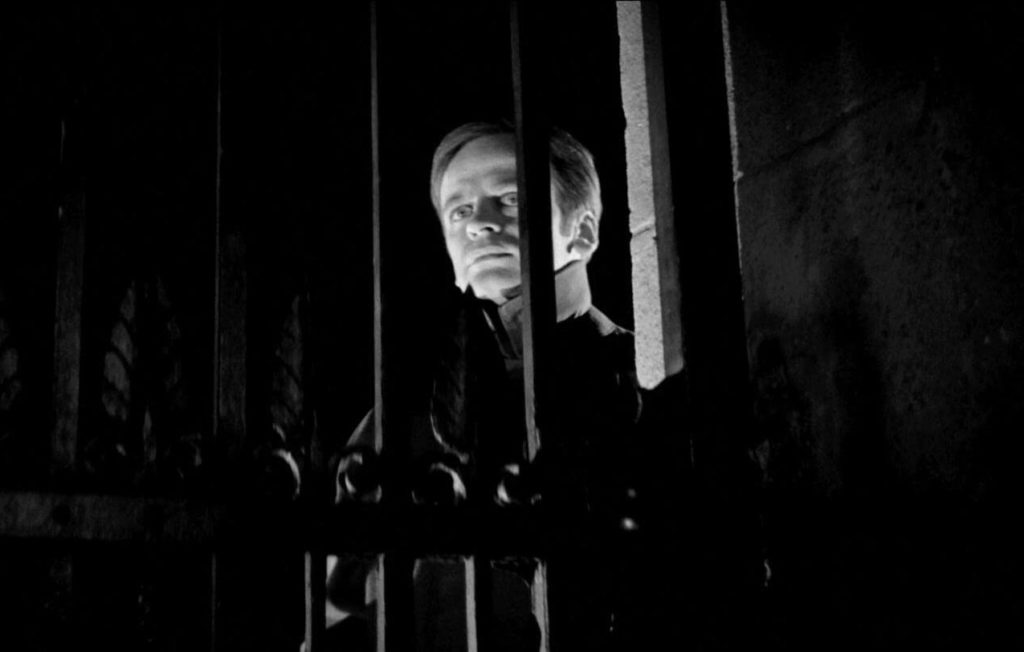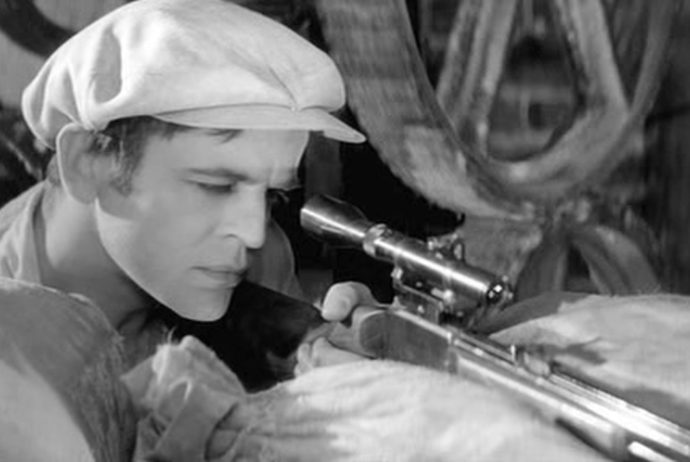Dir: Franz Josef Gottlieb
Star: Judith Dornys, Rudolf Forster, Ernst Fritz Fürbringer, Klaus Kinski
a.k.a. The Curse of the Hidden Vault
I just hope Klaus was not being paid by the word for his performance in this krimi, because if so, his check would have been very small, if not non-existent. I don’t recall him saying a word in the entire performance, with his role being largely relegated to lurking menacingly in the background – typically behind a gate or foliage, and lit from beneath as shown below. It’s not clear until the end where his allegiances lie, when his actions finally speak considerably louder than his words. This is a bit disappointing, since the opening credits proclaim “with Klaus Kinski and Eddi Arent”, but the two get very different amounts of screen time and significance to the overall story. Arent comes out thoroughly on top, which is fair enough. He’s playing his usual comedic relief, yet stays on the side of irritating, which can’t be said for all of his roles. His bumbling does occasionally prove necessary to the plot.
Speaking of which, it’s the story of Australian heiress Kathleen Kent (Dornys), who has returned from a land down under to England, with her legal advisor Ferry Westlake (Arent), to claim her inheritance. There isn’t actually much of that, as her father was taken to the cleaners by those to whom he owed money. This was mostly gambling debts, in particular owed to crooked casino owner, Mr. Real (Forster). However, as Real approaches his death bed, he suffers a pang of conscience at having left Kathleen destitute, and so wants to make things right by returning his ill-gotten gains to her. His criminal partners, led by Connor (Fürbringer) are unimpressed by this sudden burst of charity, and want to get their hands on what they see as their rightful profits.
The problem is, Real has got his assets locked up extremely tight, in a vault whose access is guarded by a series of traps, such as a tripwire which triggers a sword-swinging suit of armor. To beat the expected inheritor to the money, they have a number of plans, which begin with meeting Miss Kent at the station where she arrives, and locking her up in a hotel, to make sure she is not able to visit Mr. Real. They then send a stand-in in her place, only for the deception to be revealed by one of Real’s associates, who knows what Kathleen looks like. Further attempts then occur, up to and including masquerading as policemen, in order to get access to the vault, where they will then blow the hell out of it with dynamite.

Fortunately, Miss Kent has some allies on her side, including Inspector Angel of Scotland Yard (Harry Meyen), and Jimmy Flynn (Harald Leipnitz), who occupies a grey area between cops and robbers. There’s also no particular honor among the thieves, with mistrust the order of the day. The film begins by showcasing this, in an interesting way. It looks like we’re watching the police raiding a house where a hostage is being held. Except, after she is rescued, the words “THE END” then flash up, and we pull back to discover that we have been watching a film in a cinema. One of the customers appears to be sleeping, but when the usherette tries to wake him, it turns out he is dead, having been shot under cover of the noise of the on-screen gun-battle. It’s a striking opening. The bad news is, there’s not much else which follows that can come close.
That isn’t entirely true, with one grisly death the other highlight. Mr. Real, fed up of attempts by Connor and his gang, decamps to a room in a remote windmill. When tracked down there, and one of Connor’s gang pays a visit, Real’s mute minion George (Kinski), unleashes a false floor (below), sending the visitor plummeting into the heart of the mill machinery. Despite desperate struggles, the victim is unable to escape and is eventually caught up and crushed by the grindstones. While it may not be explicit, with very little in the way of gore, the sheer, extended duration of the demise and the about to be deceased’s screams of terror make a difficult watch. Without wishing to spoiler George’s end, let’s just say that he who sets the wheels in motion, gets the wheels in motion… A sternly-worded letter from the Health and Safety executive seems sure to follow. [The original title here was The Mill of Horrors, until that was deemed to brutal by the producers.]
Otherwise, though, it’s not particularly memorable. Kathleen is a particularly passive heroine, outside of one sequence where she throws pepper in the face of her captor, in order to stage a breakout attempt. I read a review which criticized the film for lacking a clear protagonist, and that is fair comment. It feels like Jimmy Flynn should occupy that role, except he doesn’t get enough screen time to justify it. Ferry Westlake has considerably more scenes, despite being an obvious supporting character. He’s even the one who is left by the vault with the ticking bomb, unaware of his peril due to a preceding bang on the head.
It appears to have been a fairly troubled production. Filming was delayed in order to allow other Edgar Wallace adaptations to take precedence, including Das Verrätertor. These schedule changes ended up resulting in some parts being recast, with the first choices no longer being available, e.g. Dornys’s role was supposed to have been played by Heidelinde Weiss, Leipnitz was originally intended to be Inspector Angel. Perhaps due to these issues, or perhaps just because the end result isn’t very interesting, the audience stayed away, with the 1.3 million tickets sold making it the worst-performing film of the Rialto Wallace adaptations to that point. While I’m sure Klaus enjoyed the challenge of his mute performance – or perhaps appreciated not having the tedious task of learning lines! – it does feel a less than full use of his talents.

